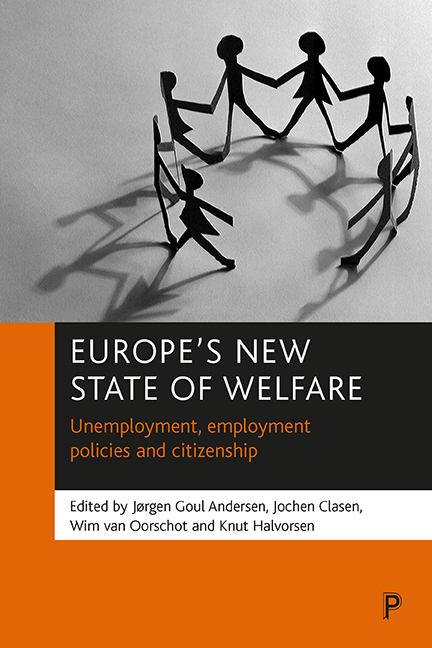Book contents
- Frontmatter
- Contents
- Notes on contributors
- Glossary
- Preface
- one Changing labour markets, unemployment and unemployment policies in a citizenship perspective
- two Employment and unemployment in Europe: overview and new trends
- three Unemployment and unemployment policy in the UK: increasing employability and redefining citizenship
- four To be or not to be employed? Unemployment in a ‘work society’
- five France: the impossible new social compromise?
- six Labour market participation in the Netherlands: trends, policies and outcomes
- seven Is high unemployment due to welfare state protection? Lessons from the Swedish experience
- eight Denmark: from the edge of the abyss to a sustainable welfare state
- nine Unemployment and (un)employment policies in Norway: the case of an affluent but oil-dependent economy: the paradox of plenty?
- ten Unemployment and unemployment policy in Finland
- eleven Slovenia’s navigation through a turbulent transition
- twelve Unemployment and unemployment policy in Switzerland
- thirteen Work, welfare and citizenship: diversity and variation within European (un)employment policy
- References
- Index
- Also available from The Policy Press
ten - Unemployment and unemployment policy in Finland
Published online by Cambridge University Press: 20 January 2022
- Frontmatter
- Contents
- Notes on contributors
- Glossary
- Preface
- one Changing labour markets, unemployment and unemployment policies in a citizenship perspective
- two Employment and unemployment in Europe: overview and new trends
- three Unemployment and unemployment policy in the UK: increasing employability and redefining citizenship
- four To be or not to be employed? Unemployment in a ‘work society’
- five France: the impossible new social compromise?
- six Labour market participation in the Netherlands: trends, policies and outcomes
- seven Is high unemployment due to welfare state protection? Lessons from the Swedish experience
- eight Denmark: from the edge of the abyss to a sustainable welfare state
- nine Unemployment and (un)employment policies in Norway: the case of an affluent but oil-dependent economy: the paradox of plenty?
- ten Unemployment and unemployment policy in Finland
- eleven Slovenia’s navigation through a turbulent transition
- twelve Unemployment and unemployment policy in Switzerland
- thirteen Work, welfare and citizenship: diversity and variation within European (un)employment policy
- References
- Index
- Also available from The Policy Press
Summary
Introduction
This chapter analyses Finnish labour markets and labour market policies. Finland achieved a solid growth rate between the mid-1970s and late 1980s, averaging 3.2% per annum between 1976 and 1989. During this period unemployment was comparatively low. However, the dominant feature of the Finnish economic landscape of the last two decades has been the recession in the early 1990s. During its gloomiest years (1991-93), Finnish GDP sank by 12%. As a part of this deep recession, Finland faced unprecedented levels of unemployment. According to OECD statistics the Finnish unemployment rate reached more than 18% in the year 1994.
Sections two and three of this chapter describe in more detail the developments in the Finnish labour markets and the main features of unemployment in Finland. In particular, attention is focused on how the increasing levels of unemployment affected different segments of the population in Finland, with special emphasis on differences between age groups, between men and women and socioeconomic groups. In section four, attention shifts to Finnish labour policies. In the early 1990s the government adopted restrictive economic policies including austerity measures and cutbacks which probably further increased unemployment. The main target of the government was to reduce budget deficit and foreign debt as much as possible and to keep the inflation rate as low as possible, regardless of how high the unemployment rate rose. It would be easy to expect this type of policy to have dramatic social consequences such as increasing economic inequality or worsening social problems. However, in retrospect, Finland overcame the economic crisis with surprisingly low social consequences. The high levels of unemployment put a strong pressure on the Finnish welfare state. The need for social security benefits increased simultaneously with declining resources to finance it. However, the Finnish welfare state succeeded surprisingly well. Income differentials did not increase during the recession, nor did the relative poverty rate. However, a closer scrutiny at the national level reveals that the Finnish society is not the same as it was prior to the recession. As the country recovers from the recession, new social divides and even possible signs of polarisation of the population have emerged, mainly as a consequence of the policies that were adopted during the recession. Section five analyses the reasons for this unexpected development.
- Type
- Chapter
- Information
- Europe's New State of WelfareUnemployment, Employment Policies and Citizenship, pp. 181 - 194Publisher: Bristol University PressPrint publication year: 2002
- 1
- Cited by



